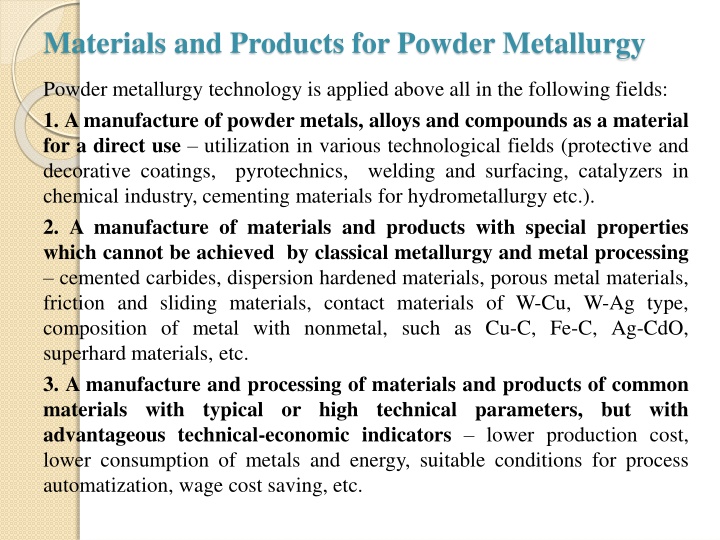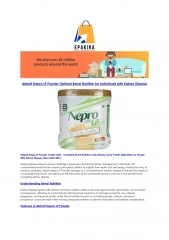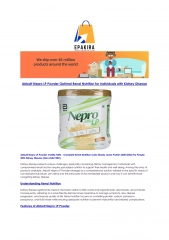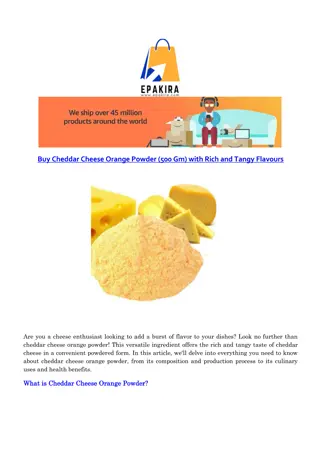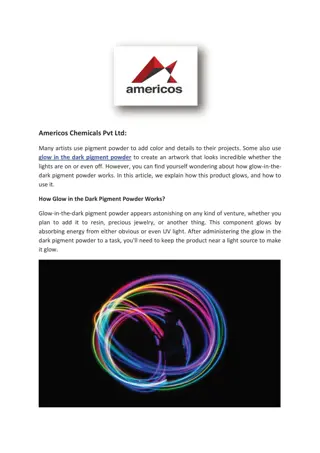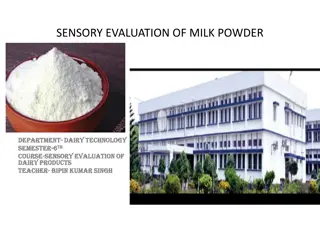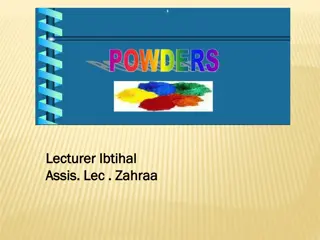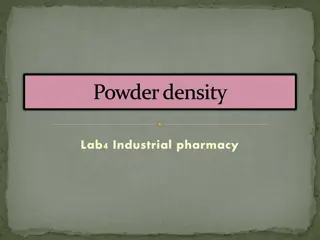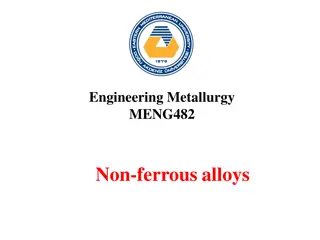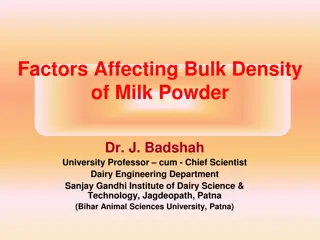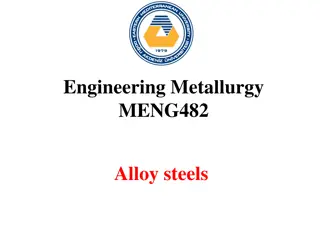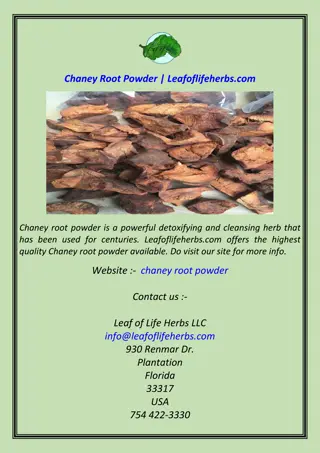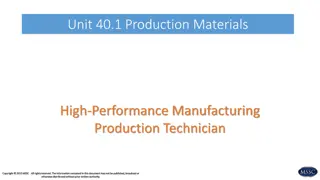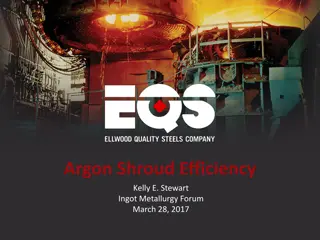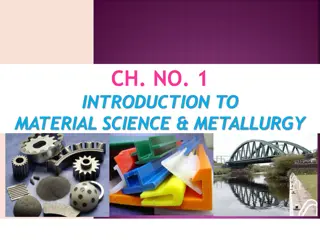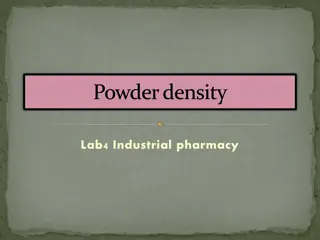Powder Metallurgy Materials and Applications
Powder metallurgy technology is used in various fields such as manufacturing powder metals, special materials, and products with unique properties, and processing common materials with advantageous technical-economic indicators. It involves using elemental and pre-alloyed metal powders to create a wide range of materials and products, including alloys, hard materials, and porous metals. This technology offers benefits in terms of production cost, energy consumption, and process automation, making it a competitive option for specific applications.
Uploaded on Apr 04, 2025 | 0 Views
Download Presentation

Please find below an Image/Link to download the presentation.
The content on the website is provided AS IS for your information and personal use only. It may not be sold, licensed, or shared on other websites without obtaining consent from the author.If you encounter any issues during the download, it is possible that the publisher has removed the file from their server.
You are allowed to download the files provided on this website for personal or commercial use, subject to the condition that they are used lawfully. All files are the property of their respective owners.
The content on the website is provided AS IS for your information and personal use only. It may not be sold, licensed, or shared on other websites without obtaining consent from the author.
E N D
Presentation Transcript
Materials and Products for Powder Metallurgy Powder metallurgy technology is applied above all in the following fields: 1. Amanufacture of powder metals, alloys and compounds as a material for a direct use utilization in various technological fields (protective and decorative coatings, pyrotechnics, chemical industry, cementing materials for hydrometallurgy etc.). 2. A manufacture of materials and products with special properties which cannot be achieved by classical metallurgy and metal processing cemented carbides, dispersion hardened materials, porous metal materials, friction and sliding materials, contact materials of W-Cu, W-Ag type, composition of metal with nonmetal, such as Cu-C, Fe-C, Ag-CdO, superhard materials, etc. 3. A manufacture and processing of materials and products of common materials with typical or high technical parameters, but with advantageous technical-economic indicators lower production cost, lower consumption of metals and energy, suitable conditions for process automatization, wage cost saving, etc. welding and surfacing, catalyzers in
The raw materials for PM processing are more expensive than for other metalworking because of the additional energy required to reduce the metal to powder form. Accordingly, PM is competitive only in a certain range of applications. In this section we identify the materials and products that seem most suited to powder metallurgy. Powder Metallurgy Materials From a chemistry standpoint, metal powders can be classified as either elemental or pre-alloyed. Elemental powders consist of a pure metal and are used in applications in which high purity is important. For example, pure iron might be used where its magnetic properties are important. The most common elemental powders are those of iron, aluminum, and copper.
Figure (1) Application of powder metallurgy products in various parts of a passenger vehicle
Elemental powders are also mixed with other metal powders to produce special alloys that are difficult to formulate using conventional processing methods. Tool steels are an example; PM permits blending of ingredients that is difficult or impossible by traditional alloying techniques.
Using mixtures of elemental powders to form an alloy provides a processing benefit, even where special alloys are not involved. Because the powders are pure metals, they are not as strong as pre-alloyed metals. Therefore, they deform more readily during pressing, so that density and green strength are higher than with pre-alloyed compacts.
In pre-alloyed powders, each particle is an alloy composed of the desired chemical composition. Pre-alloyed powders are used for alloys that cannot be formulated by mixing elemental powders; stainless steel is an important example. The most common pre-alloyed powders are certain copper alloys, stainless steel, and high-speed steel.
The commonly used elemental and pre-alloyed powdered metals, in approximate order of tonnage usage, are: (1) iron, by far the most widely used PM metal, frequently mixed with graphite to make steel parts, (2) aluminum, (3) copper and its alloys, (4) nickel, (5) stainless steel, (6) high-speed steel, and (7) other PM materials such as tungsten, molybdenum, titanium, tin, and precious metals.
A substantial advantage offered by PM technology is that parts can be made to near net shape or net shape; they require little or no additional shaping after PM processing. Some of the components commonly manufactured by powder metallurgy are gears, bearings, sprockets, fasteners, electrical contacts, cutting tools, and various machinery parts.
When produced in large quantities, metal gears and bearings are particularly well suited to PM for two reasons: (1) the geometry is defined principally in two dimensions, so the part has a top surface of a certain shape, but there are no features along the sides; and (2) there is a need for porosity in the material to serve as a reservoir for lubricant. More complex parts with geometries are also feasible in powder metallurgy, by adding secondary operations such as machining to complete the shape of the pressed and sintered part, and by observing certain design guidelines such as those outlined in the following section. true three-dimensional
Fe-based PM product (PM products based on iron with low or medium strength) PM product strength values can be improved through two basic methods: 1. Decreaseinporosity. 2. Alloyingwithappropriateadditives. Powder compressibility has a critical influence on a decrease in porosity of a sintered product. Fig. 2 shows that even unalloyed Fe powders differ considerably in density achievable after pressing. When using all technological possibilities for compaction (pressing, sintering, forging after sintering, HIP) and having 5 % residual porosity, iron unalloyed powders enable to obtain a value of tensile strength around 300 MPa and ductility up to 25 %.
A comparison of strength characteristics of the sintered iron and carbon steel, which are strongly dependent on density, powder properties and sintering conditions, is shown in Fig. 3. Main applications of the unalloyed iron powder are in a manufacture of machine parts for low loads and a manufacture of soft magnets working in direct current electrical fields. Iron-based alloys can be prepared by various methods: Mixing of powders of elementary metals or pre-alloys. Diffusion alloying of powders. Using pre-alloys prepared e.g. by melt atomization. Mixing of powders of elementary metals and pre-alloys, the so-called hybridealloys.
Figure (2) Comparison of compressibility of various types of Fe-powders.
Figure (3) Comparison of strength characteristics of the sintered iron and carbon steel.
